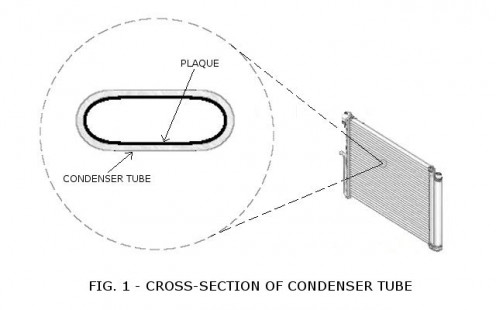Insufficient Cooling of Your Car Aircon? Plaque Inside the Condenser Could Be The Culprit.
When you have everything else ok, enough refrigerant, a new compressor (or one in excellent condition), a new dryer, strong cooling fans, and new expansion valve in your car airconditioning system and yet it is unable to provide sufficient cooling, it’s time to check the condenser.
How to check the condenser
Checking the condenser is simple. With the engine running and the aircon ‘ON’, pour water on the condenser. The pressure on your manifold gauge set, particularly the low pressure side, should drop and your aircon should now provide sufficient cooling. If this is the case, the condenser needs thorough cleaning. Not just flushing.

What could be wrong with the condenser
Fine dirts could stick on the inner walls of the condenser tubes (see Fig. 1). These fine dirts, usually black in color, usually comes from a worn out compressor. After some time of operation and because of the high temperature of the condenser, these fine dirts will be baked and will stick firmly on the walls of the condenser tubes. This plaque formation cannot be removed by the ordinary flashing procedure that we are used to.
How does the plaque in the condenser affect the cooling of the aircon system
Cooling in an aircon system is produced by evaporation. No evaporation, no cooling. Evaporation is a process in which liquid turns into gas. In an airconditioning system, evaporation takes place in the evaporator.
For evaporation to takes place, the regrigerant that enters into the evaporator must be in liquid state. If the regrigerant entering the evaporator is in gaseous state, no evaporation will take place and no cooling will result.
The refrigerant that comes out of the compressor is hot, high pressured, and in gaseous state. It should be in gas state. Gas in compressible, liquid is not.
This hot, high pressured, gas refrigerant must first be converted into liquid state before it is fed into the evaporator, as mentioned earlier. This is done by the condenser. The condenser converts the gas refrigerant into liquid through a process called condensation.
For condensation to take place, the hot gas refrigerant must be subjected to cooling. Cooling is provided by the condenser fan. If the inner walls of the condenser tubes are covered with plaque, the hot gas refrigerant will be insulated from the cool air coming from the fan by such plaque. This hampers the condensation process. Hence, the refrigerant coming out of the condenser will still be in gaseous state, or more gas than liquid. When this happens, little or no evaporation will take place in the evaporator resulting in little or no cooling at all.
How to remove the plaque
You need an aluminum cleaner, a rubber glove, plastic liquid dispenser, and a safety googles for this job. You can also use lye instead of aluminum cleaner. However, you have to make sure that you have very mild mixture of lye and water. A strong lye mix could quickly eat up the condenser tubes.
Here’s how to remove the plaque
1. It would be better if the condenser is removed. Cleaning the condenser will be a lot easier if it is taken out. Be sure to remove the drier element, if the dier is an integral part of the condenser.
2. Fill the condenser with aluminum cleaner using the plastic liquid dispenser. Leave it for three to five minutes to give time for the aluminum cleaner to dissolve the plaque.
3. Flush with water until the water coming out of the other end of the condenser is clear.
4. Repeat steps 2 and 3 until all the plaque is removed.
5. Drain out the water in the condenser by flushing it with compressed air.
6. Flush the condenser with RX-11.
7. Vacuum out whatever RX-11 that remains in the condenser.
The condenser is now ready for installation.
How to prevent the formation of plaque
Always replace a worn out or defective compressor, even if your aircon system is still able to provide sufficient cooling. Very fine particles coming out from worn out internal components of the compressor can stick on the walls of the condenser tubes to form into plaque. Noise and/or the dark color of the refrigerant as seen on the sight glass can indicate a defective compressor.



